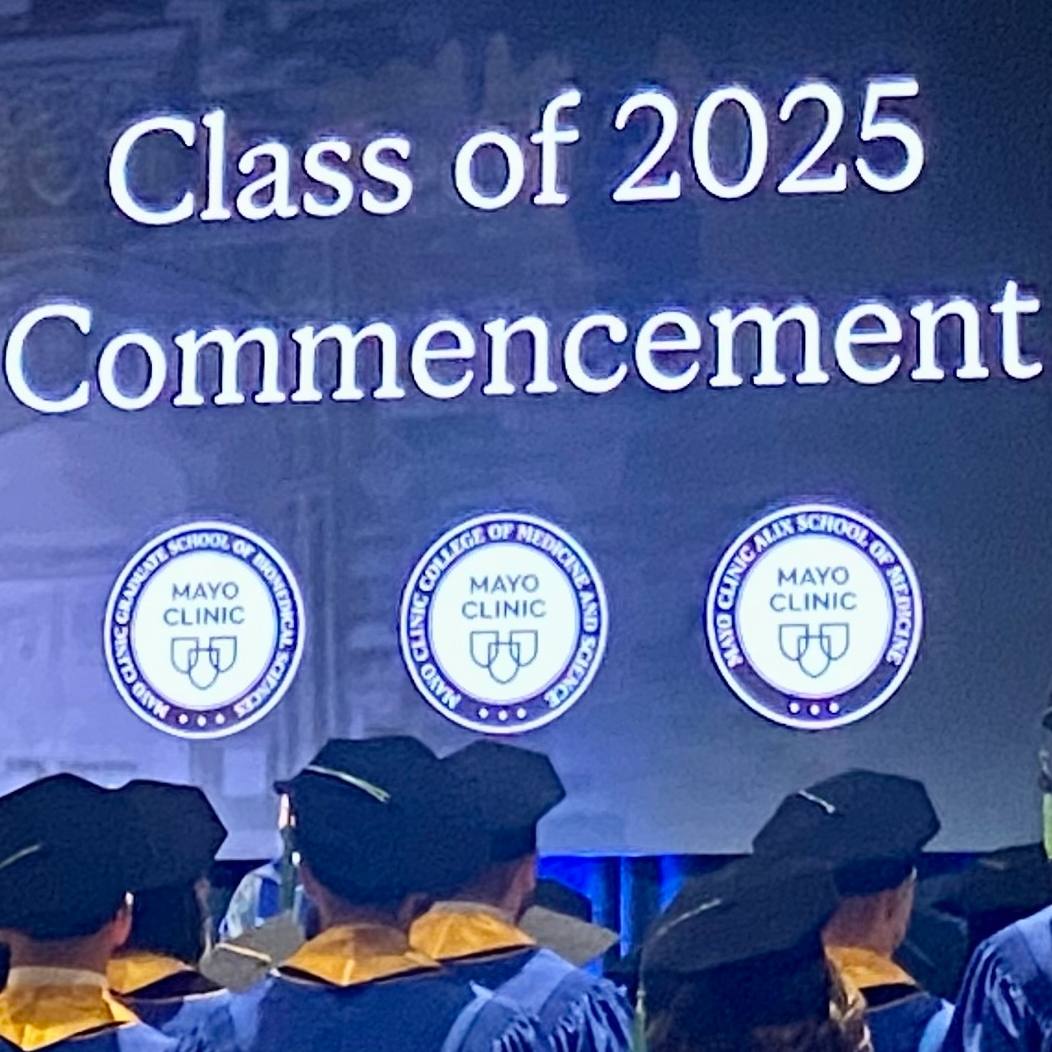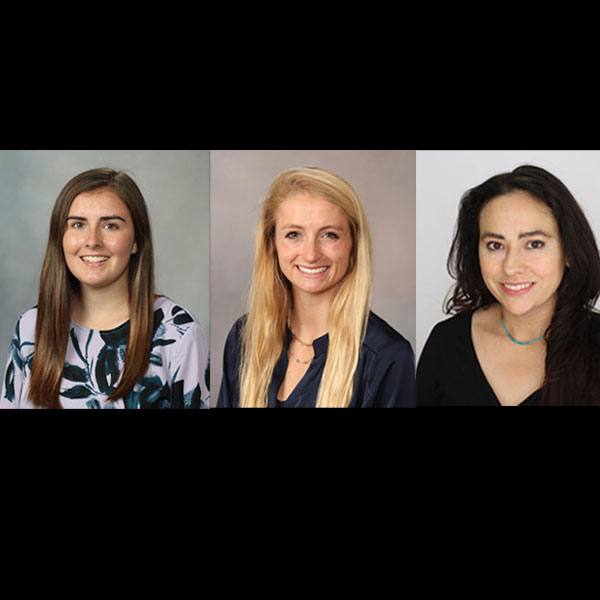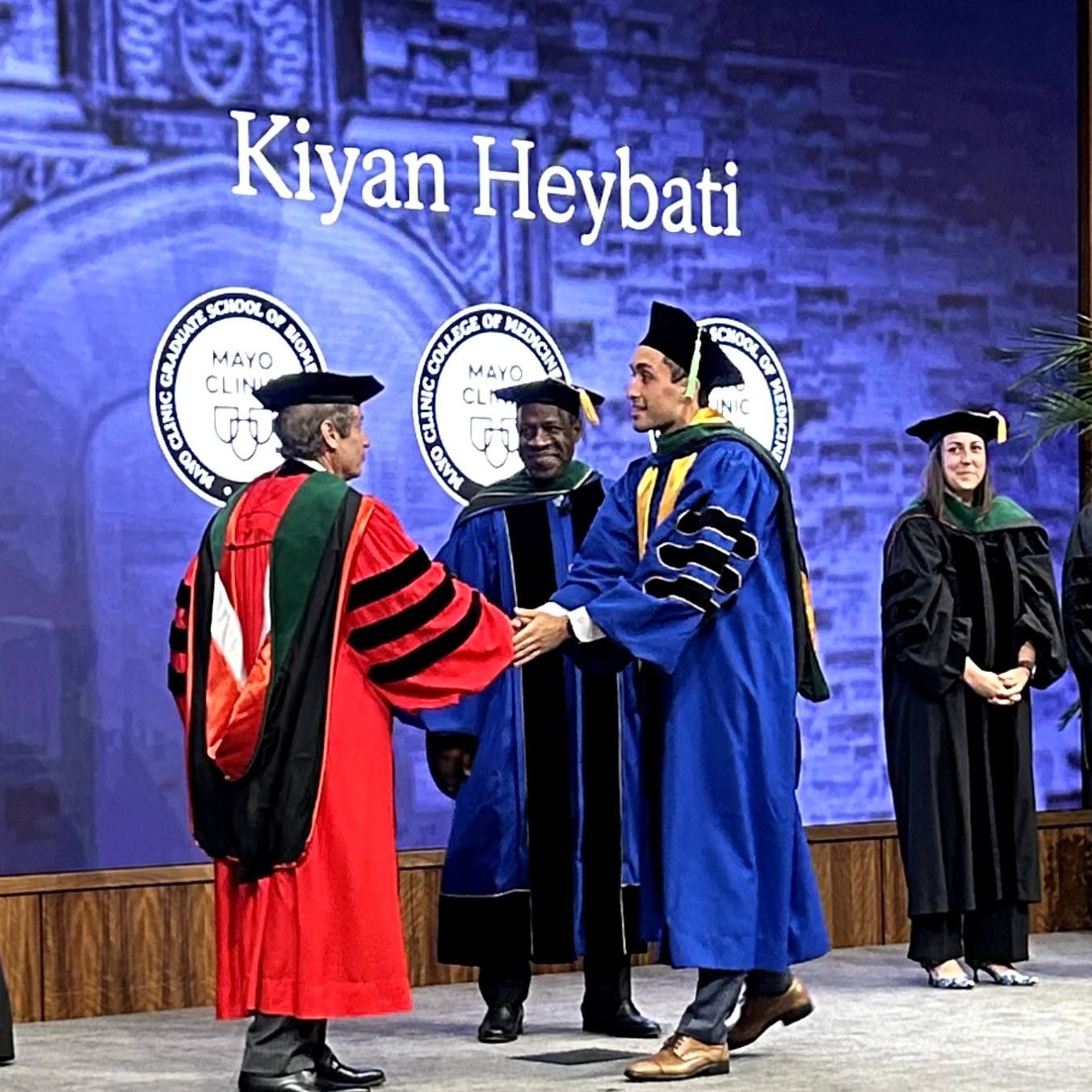-
Next Generation: Developing Tomorrow’s Researchers
The path to becoming a biomedical researcher is not for the fainthearted. It requires years of study, an insatiable curiosity and unflagging persistence in the face of failure. Three students and one former student from the Mayo Graduate School discuss what it takes to be among the next generation of these research investigators.
Hours of study, lectures to attend, research to complete, labs to monitor, data to analyze, papers to write, new solutions to old problems to noodle on. It's just another day in the life of a biomedical research student. The to-do list never seems to end. Morning to night, seven days a week.
Add being a new father to the mix and you get a glimpse into the life of Yeng F. Her, a student in biochemistry and molecular biology in his third year at Mayo Graduate School in Rochester, Minnesota, where he plans to earn both an M.D. and a Ph.D.
"I try to limit myself to six days a week for school and leave one day for family," Her says, and then laughs. "It doesn't always work."

Her is 1 of 194 students at Mayo Graduate School — and thousands in universities and graduate programs across the country — studying to become biomedical researchers. The recipe for their success will require equal parts of unflinching dedication, years of trial and error, and an unending appetite for wonder.
The long road to becoming a scientist
Few "Eureka!" moments exist in the advancement of medical science. The answer to one question leads to five more questions that also must be answered. Until suddenly something shifts, a balance tips and the world changes: Stem cell therapy can be used for healing; a new drug treatment can help people quit smoking; an artificial device can mimic the actions of the pancreas.
Her has concentrated his studies on trying to understand cancer caused by defects in energy metabolism. The defects result in an observed rise in cellular glycolysis, which is commonly called the Warburg effect. Its mechanisms are far from clear, but the effect is a boon in diagnosis as the Warburg effect allows cancer malignancies to be monitored by imaging scans.
In the meantime, Her has mentors to meet, an experiment to design, a lecture to prepare — and a few diapers to change.
"It's a long road to becoming a scientist," fellow student Katherine A. Hartjes says.

On the Rochester campus in her fourth year of what is typically a five-year Ph.D. program, Hartjes has always loved science. That passion has sustained her through four years of undergraduate studies and now through her Ph.D. work at Mayo Graduate School, where she is specializing in cardiovascular regeneration using bioengineered stem cells.
Before starting her own career, Hartjes will also have to complete at least one postdoctoral fellowship of one to three years. By the time she's done, she'll have spent over a decade as a student. But for Hartjes, traveling that long road has been worth it.
"I've always been motivated to contribute to scientific discoveries," she says. "Regenerative medicine is such an exciting field. It requires a lot of strategic thinking and planning. It demands creativity, and organization in both the big picture and the small details. I really enjoy that. And one day I hope to be able to translate my work into novel therapeutics for patients."
Hartjes' work in the field includes being the coordinator for Innovative Minds Partnering to Advance Cardiac Theranostics (IMPACT), a program within the Center for Regenerative Medicine that brings together undergraduate students and Mayo Clinic scientists to find new diagnosis or treatment options for hypoplastic left heart syndrome.
Kevin Bieniek, a third-year Ph.D. student at Mayo Graduate School, spends little time thinking about the future. He's too busy studying the human brain.
His long-standing interests in biology and psychology came together when he decided to pursue his Ph.D. in neurobiology. At Mayo Clinic's campus in Jacksonville, Florida, Bieniek has focused his studies of the brain on the pathological links of frontotemporal dementia and amyotrophic lateral sclerosis (ALS), also known as Lou Gehrig's disease.
"I knew coming in what I wanted to do," Bieniek says.

Still, all first-year students at Mayo Graduate School are exposed to a wide range of classes and must spend two months in at least three different laboratories before deciding on an area of focus for their studies.
"I enjoyed rotating through the different labs," adds Bieniek, who also spent a month studying in Sweden as part of an international collaboration with the Karolinska Institutet, one of the leading medical universities in Europe and an educational partner with Mayo Clinic.
"It was great exposure, especially with very translational research," Bieniek recalls. "There are so many different ways to approach how the brain functions that it was important for me to see how other labs in other departments were dealing with it."
Biomedical research is translational
In medicine, the term "translational" refers to scientific research that involves multiple disciplines and is driven by the need for practical applications that help people.
"Translational science is team science," says Louis (Jim) J. Maher III, Ph.D., dean of the Mayo Graduate School. "Having students understand the benefits and needs for collaboration is crucial to their future successes and for the advancement of biomedical research."
Almost by definition, biomedical research is translational.
Biomedical researchers must first understand how the body's systems function before seeking innovative ways to prevent and treat diseases. Translational biomedical research's ultimate goal is to develop effective new treatments and cures for diseases and conditions across the spectrum of health care.
These discoveries often require researchers to work with colleagues in different fields of scientific study, and they can yield astonishing breakthroughs in the understanding and treatment of diseases.
In many ways, team medicine is how Mayo Clinic has operated since the inception of the Mayo Clinic family medical practice over 150 years ago.
"That culture is uniquely Mayo," says Bruce F. Horazdovsky, Ph.D., associate dean at Mayo Graduate School. "Dr. William W. Mayo once said, 'No one is big enough to be independent of others.' We are training students to continue that tradition of collaborative learning."

And it's a philosophy embraced by the biomedical research students.
Bieniek says collaborative learning was a key factor in his decision to attend Mayo Graduate School instead of a different graduate program.
"I came here because I knew Mayo valued research and they valued collaboration," Bieniek says. "I can learn so much more about the human brain if I have the chance to study with dedicated people doing interesting work, whether they're in different departments at the clinic or in Sweden. We're all working toward a common goal."
Where students are 'paid to learn'
One of five schools in the Mayo Clinic College of Medicine, Mayo Graduate School was established in 1989 to offer careers in biomedical science and education. After partnering with the University of Minnesota for its graduate studies for over 70 years, Mayo Clinic created its own graduate school with a fundamentally different model than that of most university programs.
Students like Her, Hartjes and Bieniek compete for admission into the M.D.-Ph.D. or Ph.D. programs and for any of the seven tracks of educational emphasis. After the first year, they select an area of specialization, a laboratory and a mentor with whom to work.
What they don't have to worry about when making their decision, however, is funding.
This is a significant distinction between Mayo Graduate School and funding models at most universities and institutions. Ph.D. students at Mayo Graduate School are fully funded for five years by a central fellowship, which they bring to the laboratory or mentor of their choice.
According to Dr. Maher, most graduate schools limit funding for the first six to 12 months, after which students have to depend on other sources to cover their salary and benefits.
"Our students are not employees of a particular researcher," says Dr. Maher, who is based on the Rochester campus. "They are not tied to that person's ability to raise funds for the research. They are free agents, if you will. They are paid to learn."
This funding model allows graduate students to study with scientists in different disciplines, increasing their understanding of how advances in other fields may benefit their own research. When funding is controlled by mentors and their laboratory, students don't have this unique opportunity to expand the breadth of their knowledge.
"We don't want them training to be clones of their mentors," says Dr. Horazdovsky, also on the Rochester campus. "We want independent, creative students who will build on the innovations of today and change the world for the better tomorrow."
Curiosity and persistence
Students Her, Hartjes and Bieniek share some common attributes in their drive to succeed: determination and persistence, an unrelenting work ethic, good organization and communication skills, and an ability for strategic planning.
But the one characteristic they all agree on is an unquenchable curiosity. Curiosity is an essential element to science — some would say it's the first job requirement.
"You have to want to know how things work," Bieniek says, "and then why they don't work when something breaks down."
Her agrees but emphasizes that curiosity doesn't always lead to success. "You have to be naturally curious," he says. "But you also have to have a short memory. Ninety percent of what I do results in failure. The next day, I have to come back and figure out a way to do it different, better."
There is also a need, Hartjes points out, to bring scientific rigor to her research studies. "Good researchers must constantly strive to pursue the unknown," she says. "It takes unwavering commitment to the scientific question, rigorous experimental design and personal ownership of the quality of the research. Patience and perseverance are critical attributes to overcome the many obstacles in the scientific process."
These characteristics are all crucial, Dr. Maher says.

"Science research is incredibly difficult," he says. "It's fraught with obstacles and frustrations. Only people driven by curiosity and capable of persistence in the face of failure and rejection will survive in the business. That being said, biomedical research fields are full of joy if one knows where to look."
From student to professor
One person who understands well the unique culture created at Mayo Graduate School is molecular biologist Jennifer Jane (Jennifer) Westendorf, Ph.D. She has come full circle since her own days as a graduate student at the school and is now a professor of biochemistry, molecular biology and orthopedics on its faculty.
A member of the 1996 graduating class, Dr. Westendorf received postdoctoral training at St. Jude Children's Research Hospital and Vanderbilt University before joining the faculty at University of Minnesota. In 2007, she returned to Mayo Clinic to teach and to continue her research into the molecular basis for skeletal formation and bone repair, as well as the growth of bone tumors.
As a mentor, she takes an active interest in the studies and careers of the students working in her osteoblast laboratory. Dr. Westendorf is proud of the talented young investigators and students who work with her, but she also knows that sometimes the role of the mentor is to temper their youthful enthusiasm with a dose of reality.
"Part of mentoring," she says, "is to lay out expectations and give trainees a sense of the road ahead. It will include frustrations. It will include failure, but one success can sustain a scientist for a long time.
"It's exciting to see young students grow and experience the thrill of discovery," Dr. Westendorf says. "They have to take risks to succeed, but I can help them identify what risks are worth taking. They also have to develop the confidence to persist through the tough times. Mentoring helped me with that when I was a student. Now, I like to think I'm repaying the favor."
And it's a favor that Her, Hartjes and Bieniek will gladly repay someday. But in the meantime, they have lectures to attend, research to conduct, experiments to design — and a few diapers to change.
-- Jeffrey Briggs
July 2015







